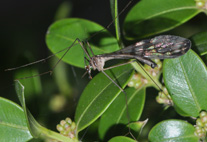Abstract
The first-instar larva of the hanging-fly Bittacus trapezoideus Huang & Hua, 2005 is described using scanning electron microscopy for the first time. The eruciform larva bears three pairs of thoracic legs and eight pairs of abdominal prolegs. Like other species of the family Bittacidae, the larval head is remarkable for bearing a median ocellus frontally and a pair of compound eyes laterally. Each compound eye consists of seven ommatidia. The larval trunk is symmetrically furnished with furcated protuberances. The larva of B. trapezoideus is diagnostic for bearing short brush-shaped setae on dorsal protuberances. In addition, the labial palp possesses nine basiconic sensilla on the apex; the abdomen bears a pair of sensory protuberances beside the protrusible sucker. The function of the furcated protuberances is briefly discussed.

